Beware the EPA Jabberwocky!
Yesterday, the LA Times ran a front page article on PLF’s landmark case of Rapanos v United States. In that case, the Supreme Court determined federal officials have no authority under the Clean Water Act to regulate all tributaries and reaffirmed that remote, isolated water bodies, including some wetlands, are off limits to federal regulation. The court reiterated that Congress expressly recognized in the Act that the States have the “primary right and responsibility” to protect local land and water use. Therefore, the oft-quoted claim that “60% of the Nation’s streams and millions of acres of wetlands” are unprotected due to the Rapanos decision is nonsense. Waters the federal government can’t regulate because of statutory and constitutional constraints are regulated by the States.
Nevertheless, the Corps and EPA assert they must adopt a new rule to “clarify” the reach of the Clean Water Act. Unfortunately, the new rule, which may be issued this week, doesn’t clarify anything other than the belief that federal officials can control virtually all waters and much of the land in the Country without federal authority. As we noted in our blog post, The EPA Administrator is a prankster, the new rule turns the Clean Water Act on its head and introduces a series of ambiguous words that Corps and EPA officials can exploit to impose their will on private landowners throughout the Nation.
The LA Times article got me thinking about Jabberwocky; the nonsense poem written by Lewis Carroll in Through the Looking-Glass that relies on made-up words that only have meaning to the author in the inverted, dreamscape world of Wonderland. The poem is an apt comparison to the proposed rule redefining “navigable waters” because it defines words in a way that defy common understanding. For example, the word “navigable” is defined to include nonnavigable. The word “waters” is defined to include areas of mostly dry land. The word adjacent, which normally means abutting, is defined to include neighboring which means whatever government officials say it means, on a case-by-case basis. The term “surface water” may include groundwater and “continuous flow” includes occasional flow. These are all words which the Corps and EPA use to define waters subject to federal regulation. So, when you hear the new rule is necessary to protect the waters of the United States and the rule simply clarifies, but does not extend, federal jurisdiction, you can be sure you just fell down the rabbit hole into an upside down world.
Our most recent critique of the proposed new rule can be found here.



